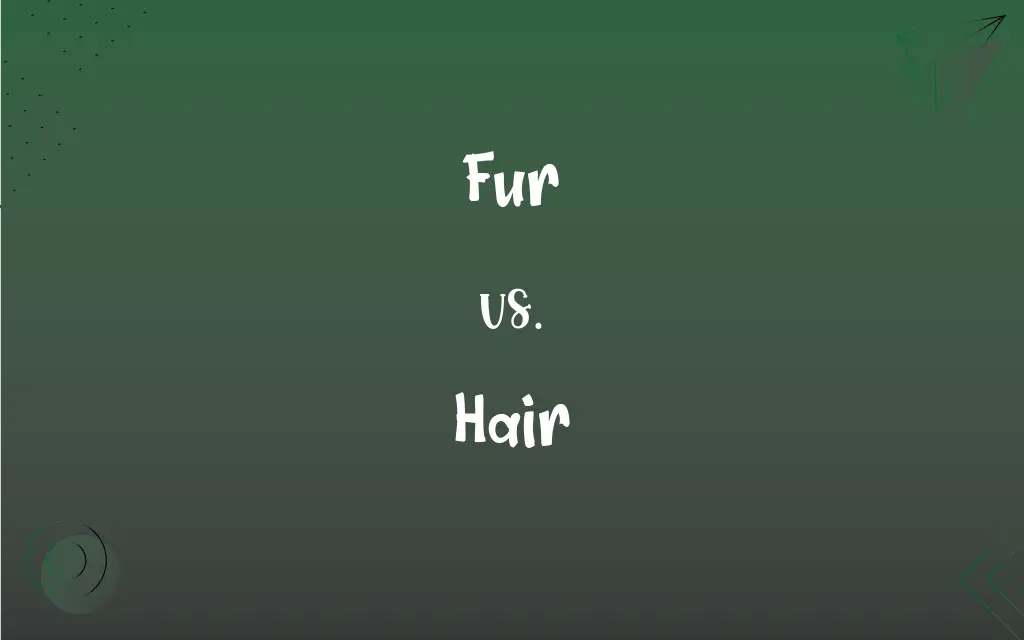Fur vs. Hair: What's the Difference?
Edited by Aimie Carlson || By Harlon Moss || Updated on October 21, 2023
Fur is a dense coat on mammals for insulation, while hair is thin, elongated keratin strands growing from follicles on humans and some animals.

Key Differences
Fur primarily refers to the thick coat of soft hair covering the skin of many mammals. This layer provides insulation, protection, and camouflage. In contrast, hair typically denotes the strands growing primarily on the scalps of humans and some animals.
One can think of fur as a complex, integrated system often involving shorter ground hairs and longer guard hairs. These combined layers aid in regulating body temperature. Meanwhile, hair generally grows longer and doesn't always serve the same dense protective function as fur.
While both fur and hair are made of the same protein, keratin, the growth cycle of fur is usually faster and has a more definite end, leading to shedding. Hair, on the other hand, has a longer and more varied growth cycle.
In the fashion and textile industries, fur denotes the soft, hairy coat of mammals, often used to create luxury garments. In comparison, hair in these industries might refer to human hair used for wigs or extensions.
The care and grooming of fur and hair also differ. Animals with fur might require different grooming techniques to keep their coats healthy and clean, whereas hair, especially human hair, has an extensive range of care products and routines.
ADVERTISEMENT
Comparison Chart
Primary Location
Mammalian skin
Human scalp & some animals
Function
Insulation, camouflage, protection
Mostly aesthetic, some protection
Growth Cycle
Faster, more definite ending
Longer, more varied cycle
Industry Usage
Luxury garments, textiles
Wigs, extensions
Maintenance
Animal grooming
Human hair care routines
ADVERTISEMENT
Fur and Hair Definitions
Fur
The soft, thick covering on a mammal's skin.
The cat's fur was silky smooth to the touch.
Hair
Keratin strands primarily found on the human scalp.
His hair was turning gray with age.
Fur
A coat consisting of dense, soft hairs.
The rabbit's fur provides it with insulation against the cold.
Hair
A growth that can be styled, trimmed, or colored in humans.
She got her hair dyed red.
Fur
The hairy hide of an animal processed for clothing.
Her coat was made of genuine fox fur.
Hair
Threadlike strands growing from the skin of humans and animals.
She brushed her hair every morning.
Fur
Mammalian outer covering that can vary in density and length.
The fur of polar bears is specialized to handle extreme cold.
Hair
Human strands often used in cosmetic or fashion applications.
The wig was made of real human hair.
Fur
A pelt used in the fashion industry for garments.
The demand for fur coats has decreased due to ethical concerns.
Hair
The filamentous biomaterial extending from the epidermis.
The horse's mane consists of long hair.
Fur
The thick coat of soft hair covering the skin of certain mammals.
Hair
Any of the cylindrical, keratinized, often pigmented filaments characteristically growing from the epidermis of a mammal.
FAQs
Can humans have fur?
No, humans have hair, not fur.
What is fur made of?
Fur, like hair, is made of the protein keratin.
Why do some animals shed their fur?
Animals shed fur to renew their coat and adapt to changing seasons.
What is the main function of fur?
Fur primarily provides insulation, protection, and sometimes camouflage.
Can hair serve as insulation like fur?
While hair can provide some insulation, it's not as effective as the dense fur on many mammals.
How does hair growth differ from fur growth?
Hair generally has a longer and more varied growth cycle than fur.
Can fur be artificially created?
Yes, there are synthetic fur materials made to mimic natural fur's look and feel.
Why is fur used in fashion?
Fur has been prized for its warmth, softness, and luxury appeal.
Is human hair identical in structure to animal hair?
While similar in basic structure, there are differences in texture, growth rates, and function.
How long can human hair grow?
With few exceptions, human hair can grow very long if uncut, often reaching several feet.
Is fur only found in mammals?
Primarily, yes, fur is a characteristic of mammals.
What animals have the thickest fur?
Animals like the sea otter and polar bear have notably thick fur for insulation.
Why does hair turn gray?
Hair turns gray due to a reduction in melanin production as people age.
Are there ethical concerns about fur?
Yes, concerns about animal welfare have led many to oppose fur farming and trading.
Is fur only soft?
While many furs are soft, some can be coarse or wiry depending on the animal.
Is hair only found on the head?
No, hair can be found on many parts of the human body, but it's most prominent on the scalp.
How do people style or manage hair?
People style hair using products, cutting, dyeing, and various hair tools.
Can hair be donated?
Yes, many donate their hair to organizations making wigs for cancer patients or others.
Why do animals have different fur colors?
Fur colors provide camouflage, attract mates, or are adaptations to their environment.
How do you maintain healthy hair?
Healthy hair can be maintained with regular cleaning, conditioning, and protection from damage.
About Author
Written by
Harlon MossHarlon is a seasoned quality moderator and accomplished content writer for Difference Wiki. An alumnus of the prestigious University of California, he earned his degree in Computer Science. Leveraging his academic background, Harlon brings a meticulous and informed perspective to his work, ensuring content accuracy and excellence.
Edited by
Aimie CarlsonAimie Carlson, holding a master's degree in English literature, is a fervent English language enthusiast. She lends her writing talents to Difference Wiki, a prominent website that specializes in comparisons, offering readers insightful analyses that both captivate and inform.































































